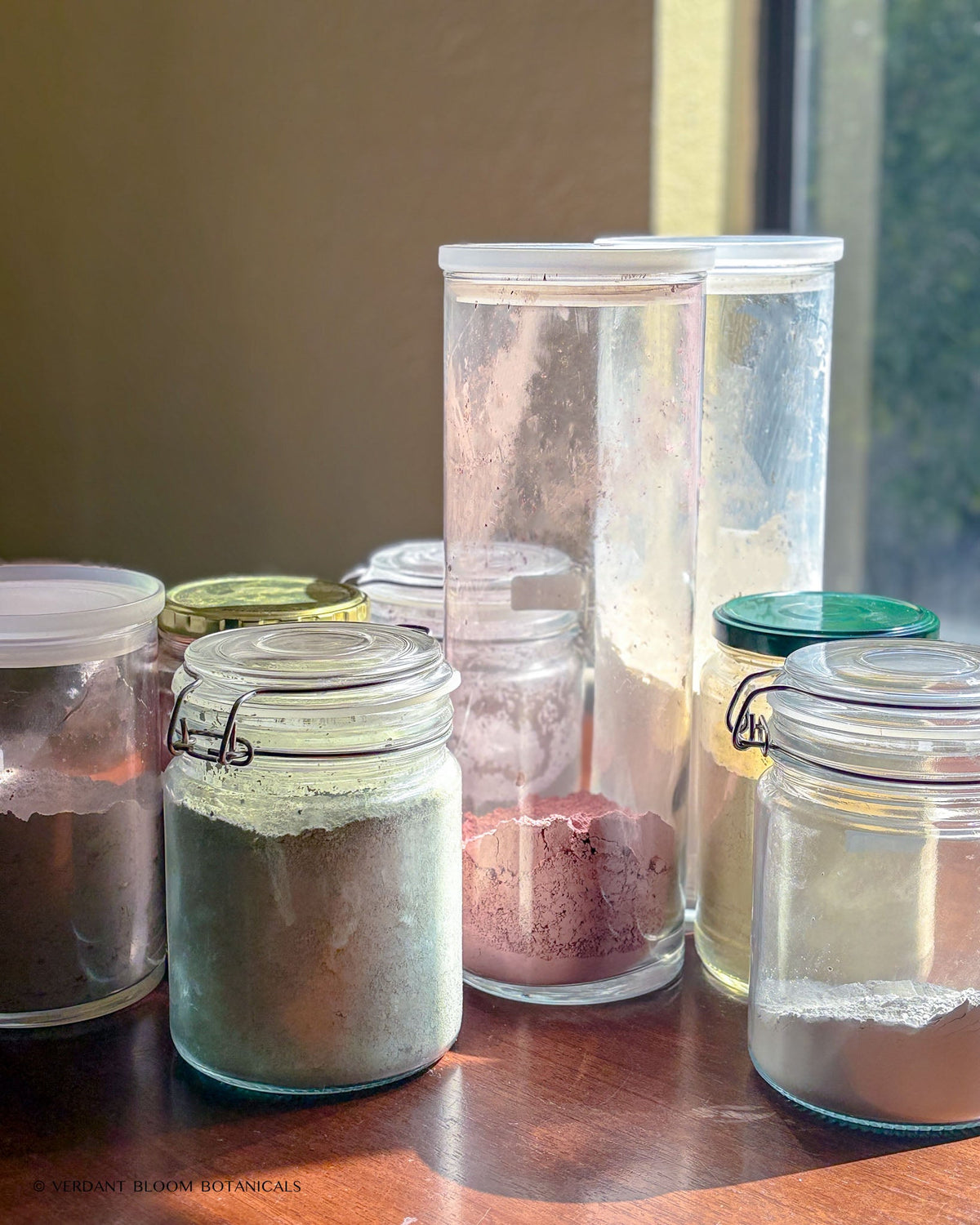
Color, Cleanse, and Care: How Natural Clays Elevate Your Handmade Soap
|
|
Time to read 4 min
|
|
Time to read 4 min
If you're new to cold process soapmaking or looking to enhance your current recipes, natural clays are a fantastic ingredient to explore. These earthy additions not only provide beautiful, natural colors without synthetic dyes, but they also offer unique benefits for the skin.
In this guide, you'll learn how to confidently use six popular natural clays—Bentonite, French Green Clay, Moroccan Nude Clay, Kaolin Clay, Rose Clay, and Rhassoul Clay—in your cold process soap. We'll walk through each clay’s color, texture, skin benefits, and ideal uses to help you make the best choice for your next batch.
Table of Content
Pre-mix: Always disperse clay in a small amount of water or oil before adding it to your soap batter to avoid clumping.
Dosage: Start with 1 tsp of clay per pound of oils. Adjust based on the color and texture you desire.
Watch for Acceleration: Some clays can speed up trace, especially in combination with certain fragrances.
Pair Thoughtfully: Match clays with complementary essential oils or botanical additives to enhance both the function and aesthetic of your bar.
Color: Pale gray to greenish-gray
Texture: Very fine and silky; swells when wet
Skin Benefits: Deeply detoxifying, excellent for oily and acne-prone skin
Best in: Facial soaps, deodorant bars, shaving soaps
Bentonite clay is made from volcanic ash and is known for its powerful ability to absorb oil and impurities. It’s especially loved in facial bars and detox soaps, where a deep clean is the goal. Because of its swelling nature, it gives soap a slippery, almost lotion-like feel—perfect for shaving bars. Use it in small amounts (about 1 tsp per pound of oils), as it can otherwise affect lather.
Color: Soft green to sage green
Texture: Fine with a slight grit
Skin Benefits: Tones and tightens skin; absorbs oils and impurities
Best in: Spa-inspired facial bars, oily skin formulations
French Green Clay gets its color from decomposed plant matter and iron oxides. It’s a go-to for oily or combination skin types because of its balancing properties. Its gentle exfoliating quality makes it ideal for facial soaps. The green hue also lends a beautiful, muted tone to your soaps. Be sure to mix it with a bit of water or oil before adding to your batch to avoid clumps.
Color: Off-white to light beige
Texture: Velvety and smooth
Skin Benefits: Gentle cleansing and skin-softening
Best in: Luxurious body bars, dry or mature skin blends
Moroccan Nude Clay is rich in iron and has been used in traditional hammams (steam baths) for centuries. It has a gentle cleansing effect that won’t strip natural oils, making it perfect for dry or sensitive skin. In soap, it gives a warm sandy hue and a creamy texture. It pairs beautifully with essential oils like rose, frankincense, or cedarwood.
Color: White to off-white
Texture: Light, fluffy, and smooth
Skin Benefits: Mild exfoliant; soothing for sensitive skin
Best in: Gentle everyday soaps, baby soaps, facial bars
Kaolin clay is one of the most versatile and gentle clays, suitable for all skin types. It doesn’t absorb oils as aggressively as other clays, which makes it ideal for dry or sensitive skin. In cold process soap, it enhances the slip and creaminess of lather. It’s a favorite in mild facial soaps and is often used to stabilize scent and color in soap recipes.
Color: Soft pink to blush
Texture: Smooth and silky
Skin Benefits: Gently detoxifies and improves circulation
Best in: Feminine soaps, facial bars, gift soaps
Rose clay is essentially kaolin clay with iron oxide, giving it its signature pink hue. It offers gentle exfoliation and detoxification without over-drying. Its romantic color makes it a popular choice for wedding favors, Valentine’s Day bars, or any soap meant to feel special and indulgent. Try pairing it with floral essential oils like rose, geranium, or lavender.
Color: Light brown to warm red
Texture: Silky and mineral-rich
Skin Benefits: Improves skin clarity, smooths and softens texture
Best in: Hair soaps, clarifying body bars, spa-style soaps
Rhassoul clay comes from the Atlas Mountains of Morocco and is known for its mineral-rich profile. It helps draw out impurities while delivering a silky, conditioning feel to the skin. It’s often used in hair care bars because of its ability to clarify the scalp while adding shine. In body soaps, it offers a luxurious feel and subtle earth-toned color.
Natural clays not only enhance the beauty of your handmade soaps, but they also elevate the skin benefits, turning every bar into a mini spa experience. Whether you’re going for a soothing rose clay bar or a detoxifying bentonite shaving soap, there’s a clay out there that’s perfect for your needs. With a little experimentation and knowledge, you’ll discover how these earthy additions can transform your cold process soaps into nourishing works of art.
Happy soaping!





